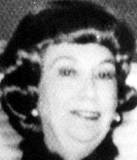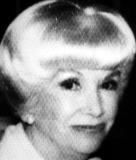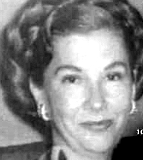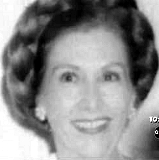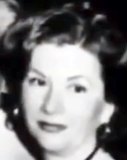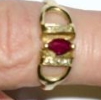Helen Marie Voorhees Brach
Helen, circa 1977; Jack Matlick; Richard Bailey; Ring, possibly Helen Brach's
- Missing Since 02/17/1977
- Missing From Rochester, Minnesota
- Classification Endangered Missing
- Sex Female
- Race White
- Date of Birth 11/10/1911 (114)
- Age 65 years old
- Height and Weight 5'10, 200 pounds
- Clothing/Jewelry Description A full-length fur coat.
- Distinguishing Characteristics White female. Red hair, brown eyes. Helen's former married name is Littlecock, and her last name is pronounced "Brack." Her ears are pierced.
Details of Disappearance
Helen kept a checkup appointment at the Mayo Clinic in Rochester, Minnesota on February 17, 1977. The doctors there found nothing wrong with her save that she was overweight. After paying her bill, Helen began walking back to her hotel. She stopped at a gift shop and purchased $41 worth of cosmetics and bath towels, telling the clerk she was in a hurry because her "houseman" was waiting. Investigators are not sure what Helen meant; she was traveling alone and no one was seen with her.
Helen did have a houseman named Jack Matlick. A photograph of Matlick is posted with this case summary. He helped run Helen's house after her husband, Frank, died. Frank had been the owner of E. J. Brach and Sons and was one of the world's wealthiest candy producers. He met Helen, a native of Ohio, when she was working as a coat-check girl at the Palm Beach Country Club in Florida.
After their marriage they lived in Chicago, Illinois during the summer and rented a house in Palm Beach, Florida in the winter. Frank and Helen apparently had a very happy relationship. He died in 1970, seven years before Helen's disappearance. He left her with an estimated net worth of $20 million.
Matlick claims he met Helen at O'Hare International Airport when she flew from Rochester back to Chicago, but the plane crew, could not remember anyone matching her description on the flight that day. They were not interviewed until a significant period of time had passed, however.
Matlick says he picked up Helen at O'Hare and drove her back to her home in Glenview, Illinois. That weekend, Matlick called his wife and said he would be staying in Glenview because he had work to do. This is uncharacteristic of him; he normally lived apart from Helen in a house she owned in Schaumburg, Illinois.
Matlick told police later that Helen had stayed in Glenview that weekend preparing for her upcoming trip to Florida. But friends who dropped by to visit her were told she was unavailable, and Helen did not call anyone, which is uncharacteristic of her.
Matlick said he drove Helen to O'Hare at 7:00 a.m. on Monday without much luggage or a flight reservation; Helen normally traveled with lots of luggage and a carefully planned itinerary. She is also a late riser who would not normally fly out so early in the morning. There is no record of Helen flying out of O'Hare that day.
Matlick said Helen signed several checks totaling $15,000 before she left; many of the checks were to his benefit. When investigators determined the checks had not, in fact, been signed by Helen, Matlick changed his story and said he had signed the checks for her because she had injured her hand. Handwriting analysis experts do not believe he actually signed the checks, however, and the signatures were never tested against anyone else's writing.
Matlick's wife said he gave her a different story about Helen's disappearance; he said she did not return from the Mayo Clinic and he was waiting for her in Glenview. That weekend in Glenview, Matlick arranged to have carpeting replaced in one of the rooms of Helen's house, and had two rooms re-painted also. The workers who did the job did not notice anything out of the ordinary about the room. Matlick had the pink Cadillac he'd been driving cleaned and waxed, and the interior shampooed.
Matlick did not try to report Helen missing for over two weeks after her disappearance. The missing persons report had to come from a family member, so he contacted her brother, Charles Voorhees, in Ohio and notified him about his sister's disappearance.
After flying to Illinois and reporting Helen missing, Voorhees and Matlick searched her Glenview home for clues. Matlick destroyed her diaries, which she had written in every day for years. Voorhees says Helen left explicit instructions that they should be burned if anything happened to her, so he allowed Matlick to burn the papers outside of his presence.
Authorities' initial suspect in Helen's disappearance was Matlick. No ransom demand had been made for Helen and investigators did not think Matlick's story was credible. He took a series of lie detector tests but the results were inconclusive.
John Cadwallader Menk, an attorney, was appointed to look after Brach's estate in her absence. He was not permitted to see her will but Matlick told him she had willed all her money to various charities and to Voorhees. Menk tried to question Richard Bailey, whom Brach had been dating at the time of her disappearance and was supposed to meet her when she flew to Florida, but Bailey hired an attorney and refused to cooperate with Menk. He would not even admit he knew Brach.
A photograph of Bailey is posted with this case summary. He was active in the city's horse market; he was the owner of Bailey Stables and Country Club Stables. Bailey had a reputation as a con artist around Chicago; he would romance recently divorced or widowed middle-aged wealthy women, then fleece them out of their money through bad investments in horses.
Bailey had introduced Helen to the horse business; her accountant estimated that she had spent $250,000 on horses. Bailey and his brother had sold Helen some horses for much more than they were worth.
Helen was declared legally dead in 1984 and her brother and some animal protection organizations got most of her money. Helen's case remained open but inactive until 1989, when a prosecutor investigating horse fraud took a closer look at her disappearance. It was revealed that Bailey had connections to Silas Jayne, the founder of the Jayne Gang, which was involved in the horse business and in organized crime.
Silas is a possible suspect in the 1966 disappearances of Renee Bruhl, Patricia Blough and Ann Miller, who vanished together from Indiana Dunes State Park in Indiana. They rode their horses at one of Silas's stables. Silas had an established reputation as a vicious, cold-blooded gangster and many feared him. Police believe he and Richard Bailey were involved in Helen's apparent abduction. They theorize that Helen realized Bailey had scammed her and was planning to tell authorities and have him jailed, and he conspired with others and had her killed to silence her.
In 1994, Bailey was charged with numerous counts of fraud and with conspiring to commit murder, soliciting to commit murder, and causing the murder of Helen. Bailey pleaded guilty to racketeering, conspiracy, mail and wire fraud and money-laundering and admitted to conning elderly widows and divorcees. He denied scamming Helen, however, or having anything to do with his disappearance. before a federal judge.
After hearing the evidence against him in Helen's case, a federal judge decided Bailey had conspired to kill her and sentenced him to life in prison. The sentence was later reduced to 30 years. Bailey is not believed to have acted alone in Helen's case, but no one else was ever charged in connection with her disappearance. If it were not for the Brach allegations, he would have been sentenced to only about 11 years in prison.
In 2005, investigators announced that an individual, later identified as Joe Plemmons, had come forward with information about Helen's alleged murder. Plemmons, a horseman who had known Helen, confessed that he and ten others, including a police officer, beat and shot her to death at the behest of Silas Jayne and his nephew, Frank Jayne Jr., and incinerated her body at a steel mill off of Interstate 65 near Gary, Indiana.
Plemmons admitted to being the shooter after signing an agreement granting him immunity from prosecution. He said Helen was murdered to keep her from going to the police about being swindled in bad horse deals. He also stated that Bailey had nothing to do with the murder.
He named nine of the conspirators; the tenth, a woman, he did not identify because he says he never knew her name. Plemmons stated that the female conspirator impersonated Helen and used her plane ticket home from the Mayo Clinic, and that Helen herself was actually driven home.
Police are searching for corroboration to support Plemmons's confession; as of yet there is not enough evidence available to charge his alleged accomplices with anything relating to Helen's case. Silas Jayne died in 1987 and Frank is serving a prison sentence in Illinois for arson; he denies involvement in Helen's disappearance, as do all the other alleged conspirators who are still living.
Plemmons has given multiple contradictory accounts of his involvement in Helen's death and is an admitted lifelong con man, but his testimony had previously helped put a man in prison for murder. He testified against Kenneth Hansen at Hansen's 1994 trial for the 1955 murders of three young boys. (Hansen is one of those implicated by Plemmons in Helen's murder. He died in prison in 2007.) Plemmons told investigators that he finally confessed to his involvement in Helen's death because he could not bear the guilt anymore.
One piece of evidence which may support Plemmons's testimony is a ruby ring, which he says fell off of Brach's finger while he was disposing of her body. He kept the ring and later turned it over to the authorities. Brach's friends and family identified it as hers, but authorities haven't been able to prove this through DNA testing. A photo of the ring is posted with this case summary.
Bailey sought a new sentencing hearing as a result of Plemmons's testimony, arguing that the evidence proved he was innocent of involvement in Helen's disappearance and should therefore be released from prison. The court ruled against him in 2005, however, stating that the evidence would be more appropriate to overturn his conviction than reduce his sentence, and in any case it did not prove he was not complicit in Helen's murder.
Matlick died in a Pennsylvania nursing home in February 2011, at the age of 79. Plemmons lives in Florida. Bailey was released from prison in 2019, at the age of 90.
Helen's remains have never been found, but foul play is suspected in her disappearance due to the circumstances involved.
Investigating Agency
- Glenview Police Department 847-729-5000
Updated 12 times since October 12, 2004. Last updated October 6, 2019; details of disappearance updated.
